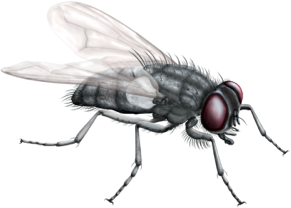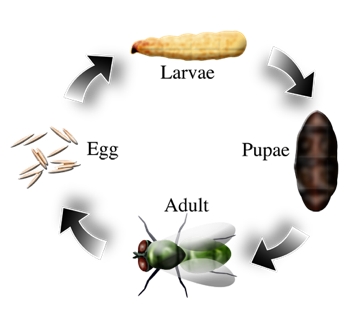Flies

Domestic flies, while often a nuisance, can also transmit germs
to people. They are attracted to foul odors from garbage, sewage,
manure, grass clippings, pet droppings, and decomposing animal
and plant waste. Flies have hairy legs (pads) and most have
sponging mouthparts (proboscis) allowing them to pick up and
deposit germs and bacteria on food, open sores or cuts, drinking
water, and cooking utensils.

Life Cycle
All flies undergo a developmental process called metamorphosis.
This process consists of four stages. All developmental stages
occur in moist and usually filthy areas containing decomposing
animal or plant waste. In the warmer summer months, flies are
able to complete their cycle in as little as 7 days. An adult
housefly typically lives about a month and can lay almost
1,000 eggs, allowing for rapid infestation in unsanitary
conditions. Most flies remain within a mile or two of where
they emerge.
Prevention:
Fly control is most successful when breeding sources are eliminated since adult flies are harder to eliminate. The following tips can be used to reduce fly populations. These suggestions are divided into urban/suburban sources and commercial/ crop production.
Urban and Suburban
• Keep all garbage in containers with tightly fitting lids or sealed bags.
• Grass clippings should be composted or spread thin to allow drying. Remove twice weekly if possible.
• Pick up pet and animal droppings daily to avoid attraction and breeding. Dispose of in closed containers or keep buried.
• Rinse out trash cans often.
Commercial and Crop
• Keep manure dry and prevent from staying wet.
• Crop and animal processing waste should be composted or removed within seven days.
• Manure used as fertilizer should be mixed into dirt promptly.
Control-The Four S's
• Sanitation
• Screening
• Swatting
• Spraying
Sanitation:
Successful fly eradication in and around the home may involve all of the above. It is likely that the sanitation measures will effectively control your fly problem. However, if flies remain a nuisance, do the following.
Screening:
Make sure all windows and door screens are tight fitting with no gaps. Placing mylar strips on screen doors or doors that open inward can dissuade flies from entering when opened.
Swatting:
The traditional fly swatter can still be effective against occasional flies that enter the home. Sticky fly traps and paper are also effective.
Spraying:
This involves the use of pesticides for control and should be used with caution. For indoor use, a non-residual pyrethrin or other spray should be used. When spraying outside, residual insecticides are most effective. Apply to surfaces where flies rest, around trash or other areas. Fly baits can be used but are only effective if good sanitation exists since baits can not compete with garbage. Fly traps are less effective and should be placed a minimum of 25ft from the residence. When spraying, remember: A Little Goes A Long Way and Always Follow Directions On the Label.
